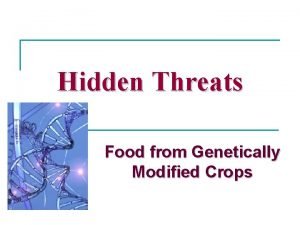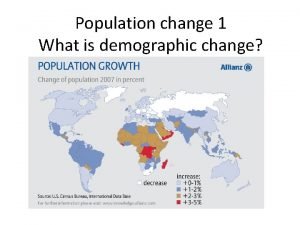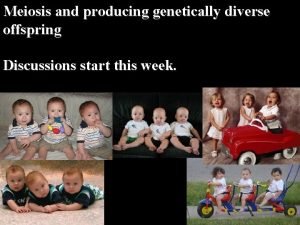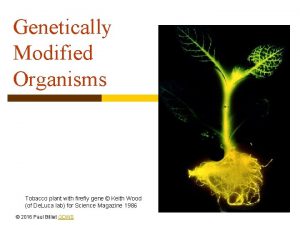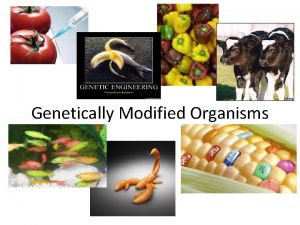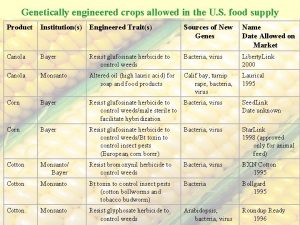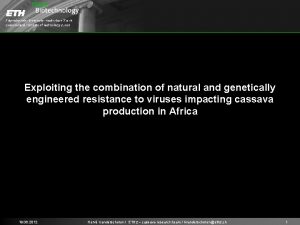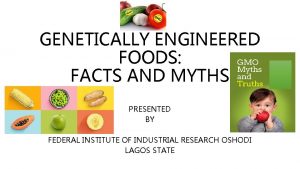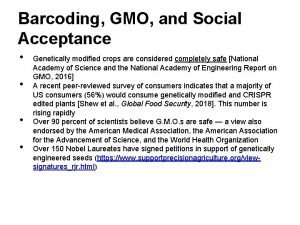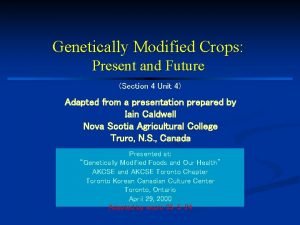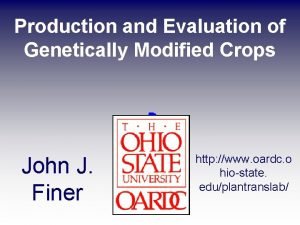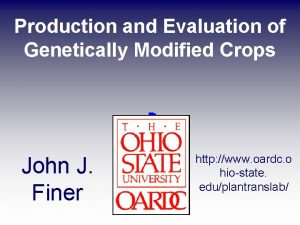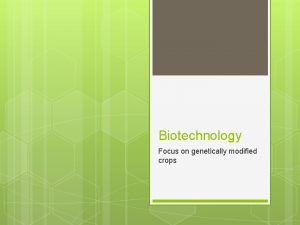Genetically Engineered Crops Experiences and Prospects May 17






















- Slides: 22

Genetically Engineered Crops: Experiences and Prospects May 17, 2016 Report Release BOARD ON AGRICULTURE AND NATURAL RESOURCES

Contextual filters that influence a person’s perception of scientific innovations

Committee’s Process • Examined the relevant literature (1000+ research and other publications) – 287 references cited in chapter on “Human Health Effects of Genetically Engineered Crops” • Held information-gathering meetings – 80 presentations (archived) • Read more than 700 comments submitted by members of the public BOARD ON AGRICULTURE AND NATURAL RESOURCES

A Key Message: No Longer Clear Distinction Between Crop-Improvement Approaches • New technologies in genetic engineering and conventional breeding are blurring the distinction between the two approaches (e. g. , Gene editing and TILLING) • It is not possible to make sweeping generalizations about the benefits and risks of GE crops • All technologies for improving plant genetics have the potential to change foods in ways that raise safety issues BOARD ON AGRICULTURE AND NATURAL RESOURCES

Committee’s Analysis of Current GE Crops • Based on experience to date – Mostly restricted to herbicide-resistant and insectresistant varieties of maize, cotton, and soybean – Data from industrial-scale and low-resource farms • Analysis conducted for: – Agronomic and environmental effects – Human health effects – Social and economic effects BOARD ON AGRICULTURE AND NATURAL RESOURCES

GE Crops and Potential Allergens • FINDING: For crops with endogenous allergens, knowing the range of allergen concentrations in a broad set of varieties grown in a variety of environments is helpful, but it is most important to know whether adding a GE crop to the food supply will change the general exposure of humans to the allergens. • FINDING: Because testing for allergenicity before commercialization could miss allergens to which the population had not previously been exposed, post-commercialization allergen testing would be useful in ensuring that consumers are not exposed to allergens, but such testing would be difficult to conduct. • FINDING: There is a substantial population of persons who have higher than usual stomach p. H, so tests of digestibility of proteins in simulated acidic gastric fluids may not be relevant to this population. BOARD ON AGRICULTURE AND NATURAL RESOURCES

Issue of Unintended Changes Endogenous Plant Toxins • More than 200, 000 secondary metabolites in the plant kingdom • Some are toxic or have adverse effects when consumed in high amounts, others are beneficial to health • Possible that genetic changes can increase levels of undesirable compounds • High natural variability in metabolites (genetically and environmentally induced) • Currently not identified as a problem in GE crops • “FINDING: Conventional breeding and genetic engineering can cause unintended changes in the presence and concentrations of secondary metabolites” BOARD ON AGRICULTURE AND NATURAL RESOURCES

Other Health Concerns Related to GE Crops • Gastrointestinal microbiota • Horizontal gene transfer • Transgenic material across the gut barrier into organs BOARD ON AGRICULTURE AND NATURAL RESOURCES

Experiences: Human Health Effects CONCLUSION: No persuasive evidence of adverse health effects directly attributable to consumption of foods derived from GE crops. CAVEAT: With any new food, GE or non-GE, there may always be some subtle favorable or adverse health effects that are not detected even with careful scrutiny, and health effects can develop over time. BOARD ON AGRICULTURE AND NATURAL RESOURCES

Gene editing – US regulatory stance • March 28, 2018, USDA Statement on Plant Breeding Innovation – “Under its biotechnology regulations, USDA does not regulate or have any plans to regulate plants that could otherwise have been developed through traditional breeding techniques as long as they are not plant pests or developed using plant pests. This includes a set of new techniques that are increasingly being used by plant breeders to produce new plant varieties that are indistinguishable from those developed through traditional breeding methods. The newest of these methods, such as genome editing, expand traditional plant breeding tools because they can introduce new plant traits more quickly and precisely, potentially saving years or even decades in bringing needed new varieties to farmers. ” • USDA’s regulations focus on protecting plant health; FDA oversees food and feed safety; and EPA regulates the sale, distribution, and testing of pesticides in order to protect human health and the environment

CRISPER Product already exists and others are coming

Which agencies have regulatory authority of biotech and its products? 74 page document can be found at: file: ///Users/hamakerb/Dropbox/Offline. Docs/18/Farm%20 Policy%20 Panel%2012 -4 -18/2017_coordinated_framework_update. pdf





What is FDA’s position – plant products? • FDA has framework to evaluate the safety of GMO’s, mainly this is around allergenicity • Because USDA will not classify gene edited plant products as “GMO’s”, it is perhaps unlikely they will enter into safety testing or the GMO labeling debate – Safety of food is supported by FD&C Act Section 402, (a food is deemed adulterated) “(a)(1) If it bears or contains any poisonous or deleterious substance which may render it injurious to health” – Labeling by Section 403, (a food is deemed misbranded) “(a)(1) If (1) its labeling is false or misleading in any particular” • FDA will issue a guidance document in 2019

FDA Issued in the Federal Register a Request for Comments on gene editing in plants in January 19, 2017 Yet to be summarized to the public and will be incorporated into the guidance document to be published in 2019

European Court of Justice Ruling • July 27, 2018 USDA statement, – “Government policies should encourage scientific innovation without creating unnecessary barriers or unjustifiably stigmatizing new technologies. Unfortunately, this week’s ECJ ruling is a setback in this regard in that it narrowly considers newer genome editing methods to be within the scope of the European Union’s regressive and outdated regulations governing genetically modified organisms. ”

FDA’s position on gene editing in animals • October 30, 2018 FDA statement – Regarding genetic modification of animals, "advance an efficient, science-based pathway to market for safe animal biotechnology-derived products. ” – This indicates that gene editing in animals will be classified as an animal drug, showing the gene alteration does not harm the animal or the environment – Criticism is that this approach has stymied new biotechnology-driven innovations in animal products • Good example is Aqua. Advantage salmon—took more than 20 years to be approved in the U. S. , but it's only so far been sold in Canada

FDA • Is developing this action plan • First Webinar was to be December 3, 2018, but was postponed • Plans to issue a guidance document for the industry in 2019

Questions?
 Advantages and disadvantages of weeds
Advantages and disadvantages of weeds Genetically modified crops
Genetically modified crops Genetically modified crops have
Genetically modified crops have Rdna technology applications
Rdna technology applications Genetically modified crops have
Genetically modified crops have Quantum computing progress and prospects
Quantum computing progress and prospects Chapter 22 genetics and genetically linked diseases
Chapter 22 genetics and genetically linked diseases The principal contrast in the passage is between
The principal contrast in the passage is between Prospects of agriculture in bangladesh
Prospects of agriculture in bangladesh World population prospects
World population prospects Prospects preposition
Prospects preposition Genetically modified organisms
Genetically modified organisms Genetically modified organisms
Genetically modified organisms Are fingerprint patterns inherited
Are fingerprint patterns inherited Diverse offspring
Diverse offspring Tobacco plant expressing firefly gene
Tobacco plant expressing firefly gene Genetically modified food
Genetically modified food The creation of genetically identical offspring
The creation of genetically identical offspring Engineered castings
Engineered castings What are engineered plans for motors called
What are engineered plans for motors called Module 00105 exam answers
Module 00105 exam answers Engineered wear products
Engineered wear products Engineered wood products unit 7
Engineered wood products unit 7


